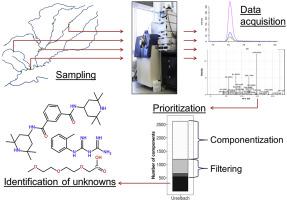当前位置:
X-MOL 学术
›
Water Res.
›
论文详情
Our official English website, www.x-mol.net, welcomes your feedback! (Note: you will need to create a separate account there.)
Application of a non-target workflow for the identification of specific contaminants using the example of the Nidda river basin.
Water Research ( IF 12.8 ) Pub Date : 2020-04-02 , DOI: 10.1016/j.watres.2020.115703 Toni Köppe 1 , Kevin S Jewell 1 , Christian Dietrich 1 , Arne Wick 1 , Thomas A Ternes 1
Water Research ( IF 12.8 ) Pub Date : 2020-04-02 , DOI: 10.1016/j.watres.2020.115703 Toni Köppe 1 , Kevin S Jewell 1 , Christian Dietrich 1 , Arne Wick 1 , Thomas A Ternes 1
Affiliation

|
Non-target screening of water samples from the Nidda river basin in central Germany was conducted with the goal to identify previously unknown chemical contaminants and their emission sources. The focus was on organic, water-borne contaminants which were not typical to municipal wastewater. Grab samples of river water from 13 locations on the Nidda and 15 of its tributaries, in sum 112 samples, were analysed with high resolution LC-QToF-MS/MS. To facilitate the identification of substances, features originating from the same compound such as adducts and isotopologues as well as in-source fragments and species with multiple charge states were registered and grouped by a componentization step utilizing both retention times and peak shapes of the features to combine them in a single component. This led to a reduction of the number of features by an average of 1235 per sample (46%). These grouped features were prioritized if these were detected only in specific tributaries or specific river sections, reducing the number of components by an average of 913 per sample (78%). In addition, grouped features were labelled as typically found in municipal wastewater by combining data from 16 wastewater treatment plants located across Germany and Switzerland and comparing this to components detected in the Nidda basin. These were removed, leading to a further reduction of components by an average of 72 per sample (30%) for an average total reduction of 2536 per sample (93%). Finally, nine compounds, with emission sources in three specific tributaries, were identified, including the textile additive Nylostab S-EED®, which was previously not known to be an environmental contaminant, as well as naturally occurring compounds such as highly toxic microcystins.
中文翻译:

以Nidda流域为例,将非目标工作流程应用于识别特定污染物。
进行了来自德国中部尼达河流域水样品的非目标筛选,目的是识别以前未知的化学污染物及其排放源。重点是有机废水中不常见的水基污染物。使用高分辨率LC-QToF-MS / MS分析了Nidda上13个地点及其15个支流中的河水样本,总共112个样本。为了促进物质的鉴定,对来自同一化合物的特征(例如加合物和同位素)以及源内片段和具有多个电荷状态的物种进行注册,并通过组分化步骤将特征的保留时间和峰形归为一组,以进行分类。将它们合并为一个组件。这导致每个样本平均减少1235个特征(46%)。如果仅在特定的支流或特定的河段中检测到这些特征,则优先考虑这些特征,从而使每个样本平均减少913个分量(78%)。此外,通过组合来自德国和瑞士的16家废水处理厂的数据,并将其与在Nidda盆地中检测到的成分进行比较,将分组的特征标记为通常在市政废水中发现的特征。去除了这些物质后,平均每个样品平均减少了2536个样品(93%),平均每个样品减少了72个样品(30%)。最后,确定了三种排放源在三个特定支流中的9种化合物,包括纺织添加剂NylostabS-EED®,
更新日期:2020-04-02
中文翻译:

以Nidda流域为例,将非目标工作流程应用于识别特定污染物。
进行了来自德国中部尼达河流域水样品的非目标筛选,目的是识别以前未知的化学污染物及其排放源。重点是有机废水中不常见的水基污染物。使用高分辨率LC-QToF-MS / MS分析了Nidda上13个地点及其15个支流中的河水样本,总共112个样本。为了促进物质的鉴定,对来自同一化合物的特征(例如加合物和同位素)以及源内片段和具有多个电荷状态的物种进行注册,并通过组分化步骤将特征的保留时间和峰形归为一组,以进行分类。将它们合并为一个组件。这导致每个样本平均减少1235个特征(46%)。如果仅在特定的支流或特定的河段中检测到这些特征,则优先考虑这些特征,从而使每个样本平均减少913个分量(78%)。此外,通过组合来自德国和瑞士的16家废水处理厂的数据,并将其与在Nidda盆地中检测到的成分进行比较,将分组的特征标记为通常在市政废水中发现的特征。去除了这些物质后,平均每个样品平均减少了2536个样品(93%),平均每个样品减少了72个样品(30%)。最后,确定了三种排放源在三个特定支流中的9种化合物,包括纺织添加剂NylostabS-EED®,


























 京公网安备 11010802027423号
京公网安备 11010802027423号